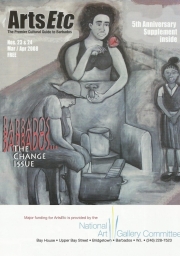
ArtsEtc Inc. 1814-6139
All works copyrighted and may not be reproduced without permission. ©2013 - hoc anno | www.artsetcbarbados.com
All works copyrighted and may not be reproduced without permission. ©2013 - hoc anno | www.artsetcbarbados.com



Published: March/April 2008
Theme: Barbados…The Change Issue
Cover: Stand-pipe 1, Vol. 1, Rono Weekes, 48” x 60”, acrylic on canvas, 2007
Contributors: Aguinaldo Belgrave, Ian Bourne, Adrian Green, Sandra E. Sealy, Gary Jerome Jones, John Robert Lee, Philip Nanton, Rono Weekes

BackPage Say #’s 23 & 24
Vanishing times ’n’ signs
By Rono Weekes
On my bike, riding around Barbados, is how I started noticing stand-pipes.
They fascinated me as a symbol of a time Barbadians saw it as their duty to help raise and protect one another’s children and to look out for each other. The stand-pipe—as a real and subliminal force, a conregation point where people carried out daily chores, exchanged information and wisdom—has all but disappeared, and in a relatively short space of time, much like the old ways.
My painting Stand-pipe 1, Vol. 1, is the first in a series utilizing the stand-pipe as a symbol of changing Barbados. The muddied shades of grey suggest the messiness of modern life. It is an indictment of modern Barbados, and, I admit, of modern Barbadian women.
I’m showing how past values play against modern values. The process is a bit negative because the end result, to me, is children being left to weather the storm by themselves. The weight of moral breakdown falls on the shoulders of the present generation, which is in disarray.
The middle-aged central figure represents a generation guilty of not passing on the values of yesteryear. She alone seems removed from the painting’s reality, and a lot of the symbolism in the painting is attached to her, e.g., the flower, out of context, emphasizing distraction and oblivion to the situation. The tap she is holding, or blocking, is dry—a commentary on her reproductiveness.
The figure on the left represents the older generation. She’s worked hard to pass on values and appears to be touching the main figure, to suggest connection. But her face is hidden to reflect shame or frustration that her lessons have not reached further. She is not scrubbing but is there in context with wash-pan and board to show she is still functional and in a position to be useful.
The third figure, although in context, appears suspended, separated from the stand-pipe and the mother/grandmother characters, signifying the break in continuity and a detachment from the earlier template for success. She is looking for something, is vulnerable, but is also a symbol of hope—dressed in school clothes to show a willingness still to learn and be guided.
Rono Weekes is an artist and a teacher. His main influences have been the minimalist and expressionist schools.